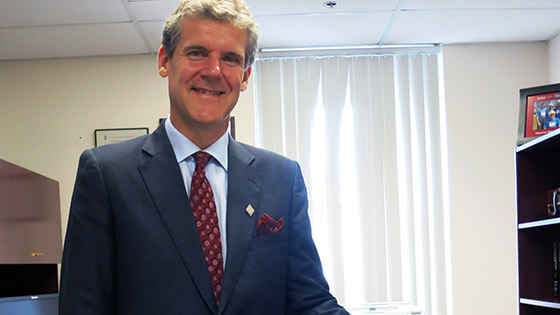 Dr. Michael Fehlings is the recipient of the H. Richard Winn Award, presented by the Society of
Dr. Michael Fehlings is the recipient of the H. Richard Winn Award, presented by the Society of
Neurological Surgeons. He is now the top cited spinal neurosurgeon in the world. (Photo: UHN)
What does it mean to be a neurosurgeon whose work has changed the treatment of spinal cord injuries?
"Winning awards is fun and cool, but ultimately, the important thing is to make it meaningful for people," said Dr. Michael Fehlings, neurosurgeon at Krembil Neuroscience Centre, scientist, professor, and now the top cited spinal neurosurgeon in the world. "If I can see somebody who is really benefiting from the work, for me, that is the biggest gratification."
This year, Fehlings received the top research award given to a neurosurgeon in North America, the H, Richard Winn, M.D. Prize, an annual award presented by the Society of Neurological Surgeons (SNS).
The award recipient receives an engraved gold medal and a leather-bound volume of peer-reviewed research published throughout their career. The SNS presented Fehlings with two volumes to accommodate all of the research papers he's published – approximately 450 studies which have been cited by other researchers at least 11,000 times.
"It's humbling and gratifying because I want to help people who have serious injuries of the brain and spinal cord in a meaningful way," said Fehlings. "It matters that people are paying attention and citing your work because it means that work is having an impact."

Richard Forster, who risked becoming a quadriplegic due to spinal cord compression, summits Zugspitze mountain, the highest peak in Germany. Decompression surgery allowed Forster to regain mobility. (Photo: UHN)
From clinical research to clinical practice
Richard Forster, 46, a husband and father of two living in Whitby, Ont., is one patient benefitting from Fehlings' impact. Forster had been living with ankylosing spondylitis (AS) for over 16 years when his condition took a turn for the worse.
AS is a form of arthritis that primarily affects the spine, causes inflammation in the spinal joints (vertebrae) and can lead to much chronic pain and discomfort. In severe cases, AS can cause ligaments to turn to bone along the vertebrae leading to rigidity of the spine.
In 2011, Forster began to notice a change in his AS symptoms. It started slowly with numbness in his fingertips and toes. His care team, led by Dr. Robert Inman, head of Toronto Western Hospital's rheumatology department, investigated whether the immune suppressant therapy used to treat his AS might be the cause. It took several tests and MRIs to discover that the ligaments running along Forster's spine had calcified and were starting to produce bone spurs which were growing between the vertebrae in his spine and crushing his spinal cord.
"There were days I couldn't walk or get out of bed," said Forster.
The symptoms got progressively worse after the diagnosis causing numbness all the way up his arms and legs. He started losing dexterity in his hands, couldn't do up the buttons on his clothes and had to ask his wife for help. He frequently dropped objects and cut himself shaving since the sensory perception in his hands needed to hold things was deteriorating.
"There were days when I couldn't walk or get out of bed because the nerves in my spine were being pinched and would swell. And when I could walk, it was very difficult," said Forster. "I would have to take short steps, it took me a long time to get anywhere and I couldn't take the stairs. At work, I would have to support myself on people's desks as I walked by."
Some days, Forster couldn't type or write which was a crucial ability for his job as a regulatory affairs specialist in the energy sector.
AS doesn't always lead to narrowing of the spinal cord, but Forster had one of the more severe cases. His care team informed him that if his condition progressed, he would most likely end up a quadriplegic.
They recommended he have surgery.
A life-altering decision
He was referred to Fehlings whose research into the use of surgery to treat spinal cord compression is changing clinical practice. Fehlings' work has shown that decompression surgery can reverse many of the impairments caused by several ailments, including AS, but the earlier a patient has surgery, the more likely they are to regain their mobility.
However, since treatment involved surgery, there was a risk. Fehlings knew the surgery could improve symptoms, but couldn't predict how much. He could only guarantee that the procedure would prevent Forster's symptoms from getting worse.
Still, a decision had to be made.
"The decision to have surgery was an obvious one," Forster said. "I had a 100 per cent risk of eventually becoming a quadriplegic as a result of my condition, versus a 2-5 per cent chance of becoming one as a result of surgery."
"I actually had more anxiety about how soon I could have the surgery since my understanding was the sooner it was done, the more likely it was I would maintain my mobility," he said.
Saving a life
On June 21, 2012, Fehlings performed the surgery.
The effects were immediate. When Forster woke up, he had more feeling in his arms and legs than he had before. He was discharged from the hospital four days after the procedure and within about one week after surgery, was able to walk around the block at home.
Forster required physiotherapy for a few months after surgery and had to learn to adapt to limited range of motion in his neck. But he continues to make progress daily and any residual effects are nothing compared to what he was living with before undergoing the procedure.
Over a year since the surgery, life has improved significantly for Forster. He can drive and has been able to start exercising regularly. This past summer, he and his wife enjoyed a trip to Europe, with highlights including: reaching the summit of Zugspitze, the highest mountain in Germany, and walking 15 kilometres around Paris – a far cry from his experience of clinging to colleagues' desks in order to move down a hallway.
"There are many different ways of saving a life," Forster said. "Saving a life doesn't just mean saving someone from imminent death. It can mean giving them their life back and I think, in many ways, this surgery has done that for me."
Since receiving the Winn Prize, Fehlings research publications now total over 480 and his citations have climbed to 12,000. He continues to see patients, do research and teach the next generation of neurosurgeons with the goals of finding more treatments and further improving the lives of those with spinal cord impairment.
